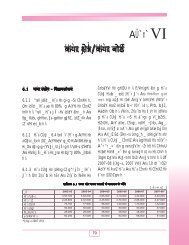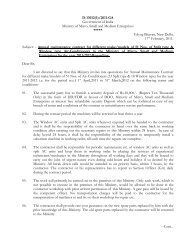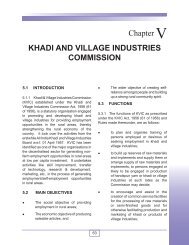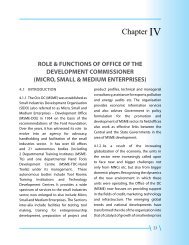Evaluation Study MSE Cluster Development - Ministry of Micro ...
Evaluation Study MSE Cluster Development - Ministry of Micro ...
Evaluation Study MSE Cluster Development - Ministry of Micro ...
Create successful ePaper yourself
Turn your PDF publications into a flip-book with our unique Google optimized e-Paper software.
Chapter No: 6 – Hard Interventions in Sampled <strong>Cluster</strong>sCHAPTER6HARD INTERVENTIONS IN THESAMPLED CLUSTERS6.1 IntroductionHard Interventions are so termed in any cluster development industrial strategy becausethey unlike s<strong>of</strong>t interventions are expected to produce concrete results by way <strong>of</strong>collectively reducing costs, improve productivity, maintain quality and standards <strong>of</strong>individual units. Hard interventions thereby enhance competitiveness in globalisedmarkets and create a level playing field, especially for a large cluster or group <strong>of</strong> smalland micro-enterprises who in their individual capacities are unable to undertake the largeinvestments required for the purpose.One <strong>of</strong> the main objectives <strong>of</strong> our evaluation study was to study the status and impact <strong>of</strong>hard interventions in the sample clusters that are being assisted under the <strong>MSE</strong>-CDP.Hard interventions involve a series <strong>of</strong> distinct processes arranged in pre-determinedstages. Each stage has to be successfully implemented before the next stage is takenup. The end result <strong>of</strong> the successful implementation <strong>of</strong> these essential stages is thesetting up <strong>of</strong> a common facility that can be utilized by all cluster actors while they pursuetheir individual enterprise activities. This common facility should be operated, managed,sustained, and even expanded independently and needs to adopt a legitimateorganizational form like any industrial enterprise or firm. It thus needs a regular andpr<strong>of</strong>essional management structure, and a work force to run and maintain its facilities.While the status <strong>of</strong> hard interventions can be judged by the specific stage that has beenachieved in each case, the impact <strong>of</strong> hard interventions emerge and can only beassessed after each <strong>of</strong> these essential stages has been successfully completed and thecommon facility built, tested and commissioned.As seen in the previous chapter there are only eleven clusters out <strong>of</strong> the 22 clusterssampled for this study that have started to implement hard interventions each <strong>of</strong> theseclusters are at different stages <strong>of</strong> implementing hard interventions and only two <strong>of</strong> theseeleven clusters have been able to successfully set up and commission common facilities.Even in these two cases the common facility has been commissioned recently and haveonly functioned for a limited period. In such a situation the impact is limited and unlessthese facilities stabilize and overcome various ‘teething’ problems a full assessment <strong>of</strong>their impact may not be possible at this early stage. Nevertheless their presentfunctioning provides early and useful indicators that help in streamlining policies andprocedures and thereby incorporating corrective features to strengthen and sustain the<strong>MSE</strong>-CDP programme in the days to come.In this chapter we shall therefore emphasize the justification for hard interventions, therationale and objectives <strong>of</strong> hard interventions, the necessary stages that have to besuccessfully negotiated and the specific constraints that emerge in each <strong>of</strong> these stages104
















